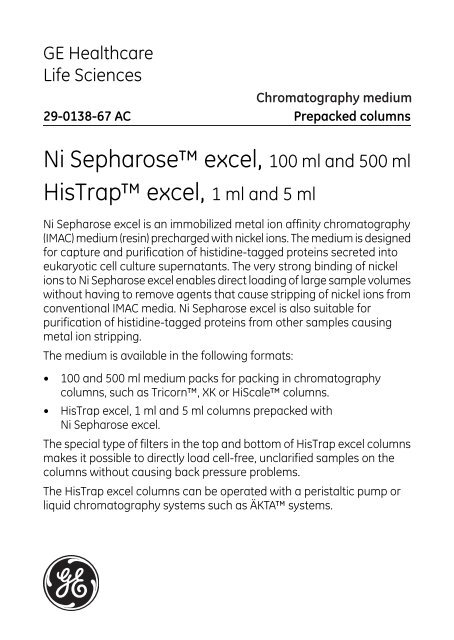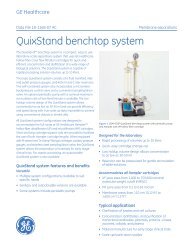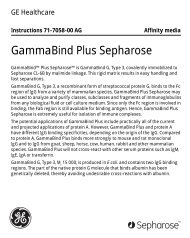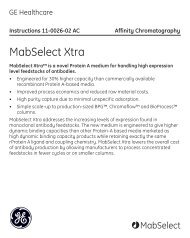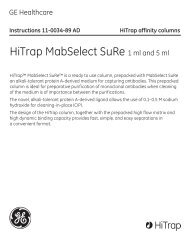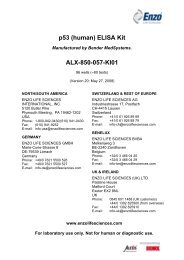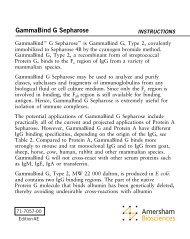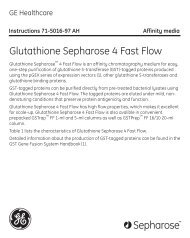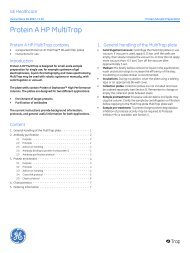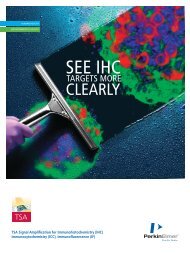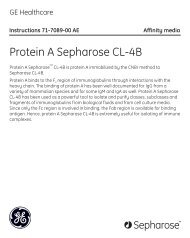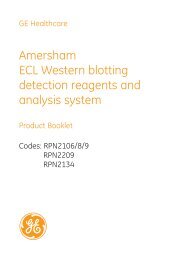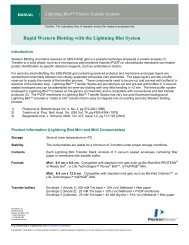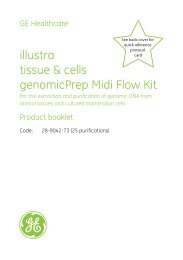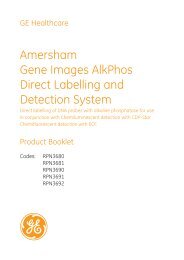Ni Sepharose™ excel, 100 ml and 500 ml HisTrap™ excel, 1 ml and ...
Ni Sepharose™ excel, 100 ml and 500 ml HisTrap™ excel, 1 ml and ...
Ni Sepharose™ excel, 100 ml and 500 ml HisTrap™ excel, 1 ml and ...
Create successful ePaper yourself
Turn your PDF publications into a flip-book with our unique Google optimized e-Paper software.
GE Healthcare<br />
Life Sciences<br />
Chromatography medium<br />
29-0138-67 AC Prepacked columns<br />
<strong>Ni</strong> Sepharose <strong>excel</strong>, <strong>100</strong> <strong>ml</strong> <strong>and</strong> <strong>500</strong> <strong>ml</strong><br />
HisTrap <strong>excel</strong>, 1 <strong>ml</strong> <strong>and</strong> 5 <strong>ml</strong><br />
<strong>Ni</strong> Sepharose <strong>excel</strong> is an immobilized metal ion affinity chromatography<br />
(IMAC) medium (resin) precharged with nickel ions. The medium is designed<br />
for capture <strong>and</strong> purification of histidine-tagged proteins secreted into<br />
eukaryotic cell culture supernatants. The very strong binding of nickel<br />
ions to <strong>Ni</strong> Sepharose <strong>excel</strong> enables direct loading of large sample volumes<br />
without having to remove agents that cause stripping of nickel ions from<br />
conventional IMAC media. <strong>Ni</strong> Sepharose <strong>excel</strong> is also suitable for<br />
purification of histidine-tagged proteins from other samples causing<br />
metal ion stripping.<br />
The medium is available in the following formats:<br />
• <strong>100</strong> <strong>and</strong> <strong>500</strong> <strong>ml</strong> medium packs for packing in chromatography<br />
columns, such as Tricorn, XK or HiScale columns.<br />
• HisTrap <strong>excel</strong>, 1 <strong>ml</strong> <strong>and</strong> 5 <strong>ml</strong> columns prepacked with<br />
<strong>Ni</strong> Sepharose <strong>excel</strong>.<br />
The special type of filters in the top <strong>and</strong> bottom of HisTrap <strong>excel</strong> columns<br />
makes it possible to directly load cell-free, unclarified samples on the<br />
columns without causing back pressure problems.<br />
The HisTrap <strong>excel</strong> columns can be operated with a peristaltic pump or<br />
liquid chromatography systems such as ÄKTA systems.
Table of Contents<br />
1 Product description .................................................................................. 3<br />
2 Buffer preparation .................................................................................... 7<br />
3 Sample preparation ................................................................................. 8<br />
4 <strong>Ni</strong> Sepharose <strong>excel</strong> protocols .............................................................. 9<br />
5 HisTrap <strong>excel</strong> protocol ............................................................................ 12<br />
6 Optimization ................................................................................................ 13<br />
7 Cleaning-in-place ..................................................................................... 14<br />
8 Storage .......................................................................................................... 14<br />
9 Tips <strong>and</strong> hints .............................................................................................. 15<br />
10 Ordering information .............................................................................. 18<br />
Please read these instructions carefully before use.<br />
Intended use<br />
<strong>Ni</strong> Sepharose <strong>excel</strong> <strong>and</strong> HisTrap <strong>excel</strong> are intended for research<br />
use only, <strong>and</strong> shall not be used in any clinical or in vitro procedures<br />
for diagnostic purposes.<br />
Safety<br />
Contains nickel. For use <strong>and</strong> h<strong>and</strong>ling of the product in a safe way,<br />
please refer to the Safety Data Sheet.<br />
2 29-0138-67 AC
1 Product description<br />
Background<br />
Traditionally, IMAC purification of histidine-tagged proteins secreted<br />
into eukaryotic cell culture supernatants is often problematic due<br />
to incompatibility with the cell culture media, leading to stripping of<br />
the immobilized metal ions during sample loading. This results in low<br />
or no binding of the target protein.<br />
The purification is further complicated by the fact that the target<br />
protein concentration often is low. This requires large sample volumes<br />
to be used, which in turn may lead to increased metal ion stripping.<br />
To overcome these problems, considerable sample pretreatment<br />
has been required, such as buffer exchange by ultrafiltration in<br />
combination with concentration procedures. Such pretreatment is<br />
time consuming <strong>and</strong> potentially harmful to sensitive proteins.<br />
General description<br />
<strong>Ni</strong> Sepharose <strong>excel</strong> <strong>and</strong> HisTrap <strong>excel</strong> (columns prepacked with<br />
<strong>Ni</strong> Sepharose <strong>excel</strong>) are products for IMAC protein purification.<br />
<strong>Ni</strong> Sepharose <strong>excel</strong> consists of 90 μm highly cross-linked agarose<br />
beads, to which a chelating lig<strong>and</strong> has been coupled. The lig<strong>and</strong> is<br />
precharged with exceptionally strongly bound nickel ions. The nickel<br />
ions remain bound even after 24 hours incubation in 10 mM EDTA.<br />
No nickel ion re-charging is required after use.<br />
Samples usually causing stripping of metal ions can be loaded onto<br />
the medium without extensive <strong>and</strong> time-consuming pretreatment<br />
procedures. Examples of samples that often cause stripping problems<br />
are cell culture supernatants containing secreted histidine-tagged<br />
proteins from eukaryotic cells, such as insect cells or CHO cells.<br />
<strong>Ni</strong> Sepharose <strong>excel</strong> <strong>and</strong> HisTrap <strong>excel</strong> are also suitable for purification<br />
of histidine-tagged proteins from other samples causing extensive<br />
metal ion stripping from conventional IMAC media.<br />
For samples without extensive stripping effects, it is recommended<br />
to use <strong>Ni</strong> Sepharose 6 Fast Flow or <strong>Ni</strong> Sepharose High Performance,<br />
which normally show higher affinity for histidine-tagged proteins.<br />
29-0138-67 AC 3
<strong>Ni</strong> Sepharose <strong>excel</strong><br />
Characteristics<br />
The flow properties of <strong>Ni</strong> Sepharose <strong>excel</strong> make it <strong>excel</strong>lent for<br />
purifications in all scales <strong>and</strong> allow loading of large sample volumes.<br />
Due to low target protein concentrations, several liters often need<br />
to be processed when purifying secreted proteins.<br />
Tricorn, XK <strong>and</strong> HiScale columns are recommended for packing of<br />
the medium.<br />
The key characteristics of <strong>Ni</strong> Sepharose <strong>excel</strong> are listed in the table<br />
below.<br />
<strong>Ni</strong> Sepharose <strong>excel</strong> characteristics<br />
Matrix<br />
Average particle size<br />
Metal ion capacity<br />
Dynamic binding capacity 1<br />
Recommended flow<br />
velocity 2 , 3<br />
Maximum flow velocity 2 2 to 12<br />
Highly cross-linked spherical agarose, 6%<br />
90 μm<br />
54 to 70 μmol <strong>Ni</strong> 2+ /<strong>ml</strong> medium<br />
At least 10 mg (histidine) 6 -tagged protein/<strong>ml</strong><br />
medium<br />
150 to 600 cm/h<br />
600 cm/h<br />
pH stability 4<br />
Working range<br />
Cleaning-in-place<br />
2 to 14<br />
Compatibility during use Stable in all buffers commonly used in IMAC<br />
Chemical stability 5<br />
- 0.01 M HCl <strong>and</strong> 0.01 M NaOH<br />
Tested for one week<br />
- 10 mM EDTA, 5 mM DTT, 5 mM TCEP,<br />
20 mM β-mercaptoethanol, 1 M NaOH,<br />
<strong>and</strong> 6 M guanidine-HCl<br />
Tested for 24 hours<br />
- <strong>500</strong> mM imidazole <strong>and</strong> <strong>100</strong> mM EDTA Tested for 2 hours<br />
- 30% 2-propanol<br />
Tested for 20 minutes<br />
Storage<br />
20% ethanol at 4°C to 30°C<br />
1 Dynamic binding capacity was tested with 0.5 mg/<strong>ml</strong> pure (histidine) 6 -tagged protein<br />
(M r 43 000) or (histidine) 6 -tagged protein (M r 28 000) spiked in EX-CELL 420 Insect serumfree<br />
medium (capacity at 10% breakthrough). Column volume was 1 <strong>ml</strong> <strong>and</strong><br />
flow rate 1 <strong>ml</strong>/min. Binding capacity is sample-dependent.<br />
4 29-0138-67 AC
2 H 2 O at room temperature. For viscous buffers <strong>and</strong> samples the flow velocity must be<br />
optimized. Starting with a low flow velocity is recommended.<br />
3 Optimal flow velocity during binding is sample-dependent. During column wash <strong>and</strong><br />
elution a flow velocity of 150 cm/h is recommended. Do not exceed 150 cm/h during<br />
cleaning-in-place (CIP).<br />
4 Working range: pH interval where the medium can be h<strong>and</strong>led without significant change<br />
in function.<br />
Cleaning-in-place: pH interval where the medium can be subjected to cleaning-in-place<br />
without significant change in function.<br />
5 Chemical stability was tested by incubating the medium in the listed solutions at room<br />
temperature, <strong>and</strong> thereafter measuring either the nickel leakage or the protein binding<br />
capacity.<br />
HisTrap <strong>excel</strong><br />
Characteristics<br />
HisTrap <strong>excel</strong>, 1 <strong>ml</strong> <strong>and</strong> 5 <strong>ml</strong>, are ready-to-use IMAC columns<br />
prepacked with <strong>Ni</strong> Sepharose <strong>excel</strong>. The design of the columns in<br />
combination with the specific properties of the medium enables fast<br />
<strong>and</strong> convenient purifications.<br />
The special type of filters in the top <strong>and</strong> bottom of the columns makes<br />
it possible to directly load cell-free, unclarified samples on the<br />
columns without causing back pressure problems. This is time-saving,<br />
which helps to prevent degradation <strong>and</strong> thus loss of sensitive target<br />
proteins.<br />
HisTrap <strong>excel</strong> columns are made of biocompatible polypropylene<br />
that does not interact with biomolecules. The columns are delivered<br />
with a stopper on the inlet <strong>and</strong> a snap-off end on the outlet.<br />
HisTrap <strong>excel</strong> columns cannot be opened or refilled.<br />
The columns can be operated with either a peristaltic pump or<br />
chromatography systems such as ÄKTA systems. For easy scalingup,<br />
two HisTrap <strong>excel</strong> columns can simply be connected in series.<br />
The key characteristics of the HisTrap <strong>excel</strong> columns are listed in the<br />
following table. For characteristics of the <strong>Ni</strong> Sepharose <strong>excel</strong> medium<br />
used in the columns, see table on page 4.<br />
29-0138-67 AC 5
HisTrap <strong>excel</strong> characteristics<br />
Column volume (CV)<br />
Column dimensions<br />
Recommended flow rate 1 , 2<br />
Maximum flow rate 1<br />
Column hardware<br />
pressure limit<br />
1 <strong>ml</strong><br />
0.7 × 2.5 cm<br />
1 to 4 <strong>ml</strong>/min<br />
4 <strong>ml</strong>/min<br />
5 bar (0.5 MPa)<br />
5 <strong>ml</strong><br />
1.6 x 2.5 cm<br />
5 to 20 <strong>ml</strong>/min<br />
20 <strong>ml</strong>/min<br />
5 bar (0.5 MPa)<br />
1 H 2 O at room temperature. Maximum flow rate will be lower when using buffers or samples<br />
with high viscosity or performing purification at low temperature.<br />
2 Optimal flow rate during binding is sample-dependent. During column wash <strong>and</strong> elution,<br />
a flow rate of 1 <strong>ml</strong>/min <strong>and</strong> 5 <strong>ml</strong>/min is recommended for 1 <strong>ml</strong> <strong>and</strong> 5 <strong>ml</strong> columns, respectively.<br />
During CIP, do not exceed a flow rate of 1 <strong>ml</strong>/min <strong>and</strong> 5 <strong>ml</strong>/min for 1 <strong>ml</strong> <strong>and</strong> 5 <strong>ml</strong><br />
columns, respectively.<br />
Note:<br />
The maximum pressure the packed bed can withst<strong>and</strong><br />
depends on the chromatography medium characteristics<br />
<strong>and</strong> sample/liquid viscosity. The value measured on the<br />
chromatography system used also depends on the tubing<br />
used to connect the column.<br />
Supplied connectors<br />
Each package of HisTrap <strong>excel</strong> columns is delivered with a variety<br />
of connectors, see the table below.<br />
Connectors supplied<br />
Usage<br />
1/16” male/luer female Connection of syringe to top of HiTrap<br />
column<br />
Tubing connector<br />
flangeless/M6 female<br />
Connection of tubing (e.g. Peristaltic<br />
Pump P1) to bottom of HiTrap column 1<br />
No. supplied<br />
1<br />
1<br />
Tubing connector<br />
flangeless/M6 male<br />
Connection of tubing (e.g. Peristaltic<br />
Pump P1) to top of HiTrap column 2<br />
1<br />
Union 1/16” female/<br />
M6 male<br />
Union M6 female/<br />
1/16” male<br />
Connection to original FPLC System<br />
through bottom of HiTrap column<br />
Connection to original FPLC System<br />
through top of HiTrap column<br />
Stop plug female, 1/16” Sealing bottom of HiTrap column<br />
1<br />
1<br />
2, 5 or 7<br />
1 Union 1/16” female/M6 male is also needed.<br />
2 Union M6 female/1/16” male is also needed.<br />
6 29-0138-67 AC
2 Buffer preparation<br />
Water <strong>and</strong> chemicals used for buffer preparation should be of high<br />
purity. Filter buffers through a 0.45 μm filter before use. Use high<br />
purity imidazole, which gives essentially no absorbance at 280 nm.<br />
Recommended buffers<br />
Equilibration buffer<br />
20 mM sodium phosphate, 0.5 M NaCl, pH 7.4<br />
Wash buffer<br />
20 mM sodium phosphate, 0.5 M NaCl, 0 to 30 mM imidazole, pH 7.4<br />
Elution buffer<br />
20 mM sodium phosphate, 0.5 M NaCl, <strong>500</strong> mM imidazole, pH 7.4<br />
Note:<br />
Note:<br />
Buffer optimization<br />
It is not recommended to include imidazole in sample <strong>and</strong><br />
equilibration buffers.<br />
Optimal imidazole concentration during wash is<br />
sample-dependent. See below for further information.<br />
Imidazole concentration in wash buffers<br />
To minimize host cell proteins in the eluate, it is recommended to<br />
include imidazole at low concentrations in the wash buffer. However,<br />
for some target proteins, even a small increase of the imidazole<br />
concentration in the wash buffer may lead to partial elution.<br />
The imidazole concentration must therefore be optimized to ensure<br />
the best balance of high purity (low binding of host cell proteins) <strong>and</strong><br />
high yield (strong binding of histidine-tagged target protein). For high<br />
purity, a higher imidazole concentration is required in the wash<br />
buffer, <strong>and</strong> insect cell culture supernatants generally require higher<br />
imidazole concentration than CHO cell culture supernatants.<br />
The concentration of imidazole that will give optimal purification<br />
results is sample-dependent, <strong>and</strong> is usually lower for <strong>Ni</strong> Sepharose<br />
<strong>excel</strong> than for other <strong>Ni</strong> Sepharose media used for IMAC purification.<br />
Finding the optimal imidazole concentration for a specific histidinetagged<br />
protein is a trial-<strong>and</strong>-error effort, but 10 to 20 mM in the wash<br />
buffer is a good starting range for many proteins.<br />
29-0138-67 AC 7
Eliminating ion-exchange effects<br />
Addition of salt, for example 0.5 to 1.0 M NaCl in buffers eliminates<br />
ion-exchange effects.<br />
Elution<br />
In general, imidazole is used for elution of histidine-tagged proteins.<br />
Alternatively, the proteins may be eluted by other methods or<br />
combinations of methods, for example by lowering pH within the<br />
range 2.5 to 5.0.<br />
With <strong>Ni</strong> Sepharose <strong>excel</strong> no recharging with nickel ions between<br />
each run is required when elution is performed using either low pH<br />
or imidazole. This is in contrast to many other IMAC media, which<br />
often have to be recharged with nickel ions after elution using<br />
low pH.<br />
Note:<br />
If the proteins are sensitive to low pH, it is recommended to<br />
collect the pH-eluted fractions in tubes containing a suitable<br />
volume of 1 M Tris-HCl, pH 9.0 to restore a neutral pH.<br />
3 Sample preparation<br />
Before sample loading, whole cells must be removed by, for example,<br />
centrifugation, otherwise clogging of the column may occur. When<br />
using HisTrap <strong>excel</strong> columns, no further clarification is needed. When<br />
using <strong>Ni</strong> Sepharose <strong>excel</strong> packed in other columns, it is recommended<br />
to also filter the sample through a 0.45 μm filter to remove cell debris<br />
<strong>and</strong>/or other particulate material.<br />
For optimal binding, it is not recommended to include imidazole in<br />
sample <strong>and</strong> equilibration buffer. It is recommended to perform<br />
binding at neutral pH. However, successful purification has routinely<br />
been observed with binding performed at a pH as low as 6.0. Due<br />
to the precipitation risk, avoid using strong bases or acids for<br />
pH-adjustments.<br />
8 29-0138-67 AC
4 <strong>Ni</strong> Sepharose <strong>excel</strong> protocols<br />
Column packing<br />
<strong>Ni</strong> Sepharose <strong>excel</strong> is supplied pre-swollen in 20% ethanol.<br />
Suitable columns for packing are the Tricorn, XK <strong>and</strong> HiScale columns,<br />
see Section Ordering information.<br />
Preparation<br />
Step<br />
1<br />
2<br />
3<br />
4<br />
5<br />
Action<br />
Allow the medium slurry to sediment for 3 hours.<br />
Add enough 20% ethanol to achieve a 1:1 ratio of settled<br />
medium <strong>and</strong> overlayed 20% ethanol.<br />
Assemble the column (<strong>and</strong> packing reservoir if necessary). 1<br />
Remove air from the end-piece <strong>and</strong> adapter by flushing with<br />
20% ethanol.<br />
Make sure no air has been trapped under the column bed<br />
support.<br />
Close the column outlet leaving the bed support covered<br />
with 20% ethanol.<br />
1 If the purification is to be performed at a high flow rate, HiScale columns are<br />
recommended.<br />
29-0138-67 AC 9
Packing<br />
Step<br />
1<br />
2<br />
3<br />
4<br />
5<br />
6<br />
7<br />
8<br />
9<br />
Action<br />
Resuspend the medium <strong>and</strong> pour the slurry into the column<br />
in a single continuous motion.<br />
Pouring the slurry down a glass rod held against the column<br />
wall will minimize the introduction of air bubbles.<br />
Allow the medium slurry to sediment for at least 3 hours.<br />
If using a packing reservoir, disconnect the reservoir <strong>and</strong> fill<br />
the remainder of the column with 20% ethanol.<br />
Mount the adapter <strong>and</strong> connect the column to a pump.<br />
Avoid trapping air bubbles under the adapter or in the inlet<br />
tubing.<br />
Immediately open the bottom outlet of the column <strong>and</strong> set<br />
the pump to run at the desired flow rate. 1<br />
Maintain packing flow rate for at least 3 column volumes<br />
(CV) after a constant bed height is reached.<br />
Stop the pump <strong>and</strong> close the column outlet.<br />
With the adapter inlet disconnected, quickly push the<br />
adapter down into the column until it reaches the bed<br />
surface <strong>and</strong> then a further 3 to 4 mm into the medium bed.<br />
Lock the adapter at this level.<br />
Connect the column to a pump or a chromatography system<br />
<strong>and</strong> start equilibration. Re-adjust the adapter if necessary.<br />
1 Should be at least 133% of the flow rate to be used during subsequent chromatographic<br />
procedures. If this cannot be obtained, use the maximum flow rate your pump can deliver.<br />
This should also give a well-packed bed.<br />
10 29-0138-67 AC
Purification protocol for <strong>Ni</strong> Sepharose <strong>excel</strong><br />
Note:<br />
For purification protocol for HisTrap <strong>excel</strong>, see next Section.<br />
Step<br />
1<br />
2<br />
3<br />
4<br />
5<br />
Note:<br />
Note:<br />
Note:<br />
Action<br />
If the column contains 20% ethanol, wash it with 5 column<br />
volumes (CV) distilled water.<br />
Recommended flow velocity: 50 to <strong>100</strong> cm/h.<br />
Equilibrate the column with at least 5 CV equilibration buffer.<br />
Recommended flow velocity: 150 to 600 cm/h.<br />
Load the sample.<br />
Recommended flow velocity: 150 to 600 cm/h.<br />
Wash with 20 CV wash buffer.<br />
Recommended flow velocity: 150 cm/h.<br />
Elute with elution buffer using a one-step procedure. 5 CV<br />
elution buffer is usually sufficient. Alternatively, a linear<br />
elution gradient (10 to 20 CV) may give higher purity, at the<br />
expense of lower target protein concentration in eluted<br />
fractions.<br />
Recommended flow velocity: 150 cm/h.<br />
A lower flow rate during sample loading might result in<br />
higher yield of the target protein.<br />
Purification at low temperatures increases the sample <strong>and</strong><br />
buffer viscosity, leading to increased back pressure. If<br />
necessary, decrease flow rate.<br />
If imidazole needs to be removed from the protein after the<br />
purification, prepacked desalting columns such as HiTrap<br />
Desalting, HiPrep 26/10 Desalting or PD-10 Desalting<br />
columns can be used, see Ordering information.<br />
29-0138-67 AC 11
5 HisTrap <strong>excel</strong> protocol<br />
Purification protocol<br />
Step<br />
1<br />
2<br />
3<br />
4<br />
5<br />
6<br />
7<br />
Note:<br />
Note:<br />
Action<br />
Fill the pump tubing with distilled water. Remove the stopper<br />
<strong>and</strong> connect the column to the chromatography system or<br />
the laboratory pump "drop-to-drop" to avoid introducing air<br />
into the column. Make sure that the connector is tight to<br />
prevent leakage.<br />
Remove the snap-off end at the column outlet.<br />
Wash out the ethanol with 5 column volumes (CV) distilled<br />
water.<br />
Recommended flow rate: 1 <strong>ml</strong>/min.<br />
Equilibrate the column with at least 5 CV equilibration buffer.<br />
Recommended flow rates: 1 to 4 <strong>ml</strong>/min <strong>and</strong> 5 to 20 <strong>ml</strong>/min<br />
for the 1 <strong>ml</strong> <strong>and</strong> 5 <strong>ml</strong> columns, respectively.<br />
Load the sample.<br />
Recommended flow rates: 1 to 4 <strong>ml</strong>/min <strong>and</strong> 5 to 20 <strong>ml</strong>/min<br />
for the 1 <strong>ml</strong> <strong>and</strong> 5 <strong>ml</strong> columns, respectively.<br />
Wash with 20 CV wash buffer.<br />
Recommended flow rates: 1 <strong>ml</strong>/min <strong>and</strong> 5 <strong>ml</strong>/min for the<br />
1 <strong>ml</strong> <strong>and</strong> 5 <strong>ml</strong> columns, respectively.<br />
Elute with elution buffer using a one-step procedure. 5 CV<br />
elution buffer is usually sufficient. Alternatively, a linear<br />
elution gradient (10 to 20 CV) may give higher purity, at the<br />
expense of lower target protein concentration.<br />
Recommended flow rates: 1 <strong>ml</strong>/min <strong>and</strong> 5 <strong>ml</strong>/min for the<br />
1 <strong>ml</strong> <strong>and</strong> 5 <strong>ml</strong> columns, respectively.<br />
A lower flow rate during sample loading might result in<br />
higher yield of the target protein.<br />
Purification at low temperatures increases the sample <strong>and</strong><br />
buffer viscosity, leading to increased back pressure. If<br />
necessary, decrease flow rate.<br />
12 29-0138-67 AC
Note:<br />
If imidazole needs to be removed from the protein after the<br />
purification, prepacked desalting columns such as HiTrap<br />
Desalting, HiPrep 26/10 Desalting or PD-10 Desalting columns<br />
can be used, see Ordering information.<br />
6 Optimization<br />
The protocols recommended in this instruction should be regarded<br />
as starting points for purification of histidine-tagged proteins<br />
secreted into eukaryotic cell culture supernatants. Some conditions<br />
may require optimization.<br />
Examples of conditions which may require optimization are:<br />
• sample loading flow rate<br />
• sample volume<br />
• imidazole concentration during wash<br />
• wash flow rate<br />
• wash volume<br />
• temperature<br />
• buffer composition, pH etc.<br />
For more information, see Section Buffer preparation.<br />
29-0138-67 AC 13
7 Cleaning-in-place<br />
When an increase in back pressure is seen, the column should be<br />
cleaned. Different methods for cleaning-in-place (CIP) are described<br />
in the table below. Do not exceed a flow velocity of 150 cm/h during<br />
CIP.<br />
To remove...<br />
Ionically bound<br />
proteins<br />
Precipitated proteins,<br />
hydrophobically<br />
bound proteins, <strong>and</strong><br />
lipoproteins<br />
Hydrophobically<br />
bound proteins,<br />
lipoproteins, <strong>and</strong><br />
lipids.<br />
Then...<br />
1 Wash with several column volumes (CV) of<br />
1.5 M NaCl.<br />
2 Wash with approximately 10 CV distilled water<br />
or equilibration buffer.<br />
1 Wash the column with 1 M NaOH, contact time<br />
usually 1 to 2 h (12 to 24 h for endotoxin<br />
removal).<br />
2 Wash with approximately 10 CV equilibration<br />
buffer.<br />
1 Wash with 5 to 10 CV 30% isopropanol for<br />
about 15 to 20 min.<br />
2 Wash with approximately 10 CV distilled water<br />
or equilibration buffer.<br />
OR<br />
1 Wash with 2 CV detergent in a basic or acidic<br />
solution. Use, for example, 0.1 to 0.5% nonionic<br />
detergent in 0.1 M acetic acid, contact time<br />
1 to 2 h.<br />
2 Remove residual detergent by washing with<br />
at least 5 CV 70% ethanol.<br />
3 Wash with approximately 10 CV equilibration<br />
buffer.<br />
8 Storage<br />
Store <strong>Ni</strong> Sepharose <strong>excel</strong> <strong>and</strong> HisTrap <strong>excel</strong> in 20% ethanol at 4°C<br />
to 30°C. Do not freeze.<br />
Make sure that the HisTrap <strong>excel</strong> column is tightly sealed to avoid<br />
drying out.<br />
14 29-0138-67 AC
9 Tips <strong>and</strong> hints<br />
The following tips may be of assistance.<br />
For further questions about <strong>Ni</strong> Sepharose <strong>excel</strong> or HisTrap <strong>excel</strong>,<br />
please visit www.gelifesciences.com/protein-purification, refer to<br />
the Data file (29-0168-49), or contact our technical support or your<br />
local representative.<br />
Issue<br />
Increased back<br />
pressure<br />
Column has clogged<br />
Compression of the<br />
gel in manually<br />
packed columns<br />
No histidine-tagged<br />
protein in the purified<br />
fractions<br />
Possible cause<br />
Suggested action<br />
• Freeze-thawing of the sample may increase<br />
precipitation <strong>and</strong> aggregation.<br />
Avoid freeze-thawing.<br />
Remove precipitate.<br />
• Increased sample viscosity.<br />
If the purification has been performed in a cold<br />
room, move to room temperature if possible. Alternatively,<br />
decrease flow rate during sample loading.<br />
• High content of particulate material in the<br />
sample.<br />
Clean the column according to Section Cleaningin-place.<br />
If column cleaning is unsuccessful,<br />
replace the column.<br />
Optimize sample pre-treatment before the next<br />
sample loading.<br />
• High viscosity, too high flow rate.<br />
Re-adjust the top adapter.<br />
• No histidine-tagged protein present in the starting<br />
material.<br />
Verify presence of histidine-tagged protein in the<br />
starting material, for example by Western blotting.<br />
• Protein found in the flowthrough: The histidinetag<br />
is not sufficiently exposed.<br />
Consider using another position for the histidinetag.<br />
• Protein found in the flowthrough: Buffer/sample<br />
composition is not optimal.<br />
Check pH <strong>and</strong> composition of sample <strong>and</strong> equilibration<br />
buffer. Make sure that the concentration of<br />
imidazole is not too high. Note that the use of<br />
imidazole in equilibration buffer <strong>and</strong> sample is not<br />
recommended.<br />
29-0138-67 AC 15
Issue<br />
No histidine-tagged<br />
protein in the purified<br />
fractions (cont.)<br />
The eluted protein is<br />
not sufficiently pure<br />
(multiple b<strong>and</strong>s on<br />
SDS polyacrylamide<br />
gel)<br />
Possible cause<br />
Suggested action<br />
• Protein eluted during wash.<br />
Ensure that the concentration of imidazole is not<br />
too high.<br />
• Elution conditions are too mild (histidine-tagged<br />
protein still bound).<br />
Elute with increased imidazole concentration.<br />
• Protein has precipitated in the column.<br />
Decrease amount of sample, or decrease protein<br />
concentration by eluting with linear imidazole<br />
gradient instead of imidazole steps. Try detergents<br />
or change NaCl concentration.<br />
• Nonspecific hydrophobic, ionic or other<br />
interaction prevents elution.<br />
Add for example a nonionic detergent to the<br />
elution buffer or change the NaCl concentration.<br />
• Partial degradation of tagged protein by<br />
proteases.<br />
Add protease inhibitors.<br />
• Contaminants have high affinity for nickel ions.<br />
Elute with a stepwise or linear imidazole gradient<br />
to determine optimal imidazole concentrations to<br />
use for wash. Increase the wash length before<br />
elution <strong>and</strong>/or the imidazole concentration during<br />
wash. A shallow imidazole gradient (20 column<br />
volumes or more) may separate proteins with<br />
similar binding strengths. If optimized conditions<br />
do not remove contaminants, adding a second<br />
chromatography step such as gel filtration may<br />
be necessary.<br />
• Contaminants are associated with the tagged<br />
protein.<br />
Add detergent or glycerol to the wash buffer to<br />
disrupt non-specific interactions.<br />
• Electrostatic interactions of contaminants with<br />
the tagged protein or the chromatography<br />
medium.<br />
Increase the sodium chloride concentration to<br />
1 to 2 M in buffers.<br />
16 29-0138-67 AC
Issue<br />
Histidine-tagged<br />
protein is eluted too<br />
early during elution<br />
Inadequate binding<br />
of histidine-tagged<br />
protein during<br />
sample loading/wash<br />
Temperature-related<br />
differences between<br />
optimization <strong>and</strong><br />
actual purification<br />
Possible cause<br />
Suggested action<br />
• When eluting using imidazole, an initial, transient<br />
pH drop may be observed. The lower pH may<br />
affect the affinity for bound proteins negatively,<br />
<strong>and</strong> a partially premature elution may be<br />
observed for loosely bound proteins.<br />
Increase the buffering capacity of the wash <strong>and</strong><br />
elution buffers, which mitigates imidazole’s effect<br />
on pH.<br />
• No histidine-tagged protein present in the starting<br />
material.<br />
Verify presence of histidine-tagged protein in the<br />
starting material, for example by Western blotting.<br />
• The histidine-tag is not sufficiently exposed.<br />
Consider using another position for the histidinetag.<br />
• Buffer/sample composition is not optimal.<br />
Check pH <strong>and</strong> composition of sample, equilibration<br />
buffer <strong>and</strong> wash buffer. Make sure that the<br />
concentration of imidazole is not too high.<br />
• Column capacity is exceeded.<br />
Change to a larger column. For example, if HisTrap<br />
<strong>excel</strong> 1 <strong>ml</strong> column has been used, change to<br />
HisTrap <strong>excel</strong> 5 <strong>ml</strong>.<br />
Note:<br />
<strong>Ni</strong> Sepharose <strong>excel</strong> is intended for IMAC<br />
purification of histidine-tagged proteins secreted<br />
into cell culture supernatants from eukaryotic cells,<br />
such as insect cells or CHO cells. It is also suitable<br />
for purification of histidine-tagged proteins originating<br />
from other samples causing nickel stripping.<br />
When purifying proteins from other types of<br />
samples, use <strong>Ni</strong> Sepharose 6 Fast Flow or<br />
<strong>Ni</strong> Sepharose High Performance.<br />
• Temperature affects column properties.<br />
If optimization is performed, always do this at the<br />
temperature intended for the actual purification.<br />
29-0138-67 AC 17
10 Ordering information<br />
Product<br />
<strong>Ni</strong> Sepharose <strong>excel</strong><br />
HisTrap <strong>excel</strong><br />
Related products<br />
His Mag Sepharose <strong>excel</strong><br />
<strong>Ni</strong> Sepharose 6 Fast Flow<br />
HisTrap FF crude<br />
HiTrap Desalting<br />
HiPrep 26/10 Desalting<br />
PD-10 Desalting Column<br />
Quantity<br />
<strong>100</strong> <strong>ml</strong><br />
<strong>500</strong> <strong>ml</strong><br />
5 × 1 <strong>ml</strong><br />
5 × 5 <strong>ml</strong><br />
Quantity<br />
2 × 1 <strong>ml</strong><br />
5 × 1 <strong>ml</strong><br />
10 × 1 <strong>ml</strong><br />
5 <strong>ml</strong><br />
25 <strong>ml</strong><br />
<strong>100</strong> <strong>ml</strong><br />
<strong>500</strong> <strong>ml</strong><br />
5 × 1 <strong>ml</strong><br />
Code No.<br />
17-3712-02<br />
17-3712-03<br />
17-3712-05<br />
17-3712-06<br />
Code No.<br />
17-3712-20<br />
17-3712-21<br />
17-3712-22<br />
17-5318-06<br />
17-5318-01<br />
17-5318-02<br />
17-5318-03<br />
11-0004-58<br />
<strong>100</strong> × 1 <strong>ml</strong> 1 11-0004-59<br />
5 × 5 <strong>ml</strong> 17-5286-01<br />
<strong>100</strong> × 5 <strong>ml</strong> 1 17-5286-02<br />
5 × 5 <strong>ml</strong> 17-1408-01<br />
<strong>100</strong> × 5 <strong>ml</strong> 1 11-0003-29<br />
1 × 53 <strong>ml</strong> 17-5087-01<br />
4 × 53 <strong>ml</strong><br />
30<br />
17-5087-02<br />
17-0851-01<br />
1 Special pack size delivered on specific customer order<br />
Empty lab-scale columns<br />
Tricorn 10/20 column, 10 mm i.d.<br />
Tricorn 10/50 column, 10 mm i.d.<br />
Tricorn 10/<strong>100</strong> column, 10 mm i.d.<br />
XK 16/20 column, 16 mm i.d.<br />
XK 16/40 column, 16 mm i.d<br />
XK 26/20 column, 26 mm i.d.<br />
Code No<br />
28-4064-13<br />
28-4064-14<br />
28-4064-15<br />
28-9889-37<br />
28-9889-38<br />
28-9889-48<br />
18 29-0138-67 AC
Empty lab-scale columns<br />
XK 26/40 column, 26 mm i.d.<br />
XK 50/20 column, 50 mm i.d.<br />
XK 50/30 column, 50 mm i.d.<br />
HiScale 16/20 column, 16 mm i.d.<br />
HiScale 16/40 column, 16 mm i.d.<br />
HiScale 26/20 column, 26 mm i.d.<br />
HiScale 26/40 column, 26 mm i.d.<br />
HiScale 50/20 column, 50 mm i.d.<br />
HiScale 50/40 column, 50 mm i.d.<br />
HiTrap accessories<br />
Quantity<br />
Code No<br />
28-9889-49<br />
28-9889-52<br />
28-9889-53<br />
28-9644-41<br />
28-9644-24<br />
28-9645-14<br />
28-9645-13<br />
28-9644-45<br />
28-9644-44<br />
Code No.<br />
1/16" male/luer female 1 2 18-1112-51<br />
Tubing connector flangeless/M6 female 1 2 18-<strong>100</strong>3-68<br />
Tubing connector flangeless/M6 male 1 2 18-1017-98<br />
Union 1/16" female/M6 male 1 6 18-1112-57<br />
Union M6 female /1/16" male 1 5 18-3858-01<br />
Union luerlock female/M6 female 1 2 18-1027-12<br />
HiTrap/HiPrep, 1/16" male connector for ÄKTA<br />
design<br />
8 28-4010-81<br />
Stop plug female, 1/16"<br />
Fingertight stop plug, 1/16" 2<br />
2<br />
5<br />
11-0004-64<br />
11-0003-55<br />
1 One connector included in each HiTrap package.<br />
2 One fingertight stop plug is connected to the top of each HiTrap column at delivery.<br />
Related literature<br />
Recombinant Protein Purification H<strong>and</strong>book, Principles <strong>and</strong><br />
Methods<br />
Affinity Chromatography H<strong>and</strong>book, Principles <strong>and</strong> Methods<br />
Affinity Chromatography Columns <strong>and</strong> Media Selection Guide<br />
Prepacked chromatography columns for ÄKTA systems,<br />
Selection Guide<br />
Data file, His Mag Sepharose <strong>excel</strong>, <strong>Ni</strong> Sepharose <strong>excel</strong>,<br />
HisTrap <strong>excel</strong><br />
Code No.<br />
18-1142-75<br />
18-1022-29<br />
18-1121-86<br />
28-9317-78<br />
29-0168-49<br />
29-0138-67 AC 19
For local office contact information, visit<br />
www.gelifesciences.com<br />
GE Healthcare Bio-Sciences AB<br />
Björkgatan 30<br />
751 84 Uppsala<br />
Sweden<br />
www.gelifesciences.com/protein-purification<br />
GE, imagination at work <strong>and</strong> GE monogram are trademarks of General Electric Company.<br />
ÄKTA, FPLC, HiPrep, HiScale, HiTrap, HisTrap, Sepharose <strong>and</strong> Tricorn are trademarks of GE<br />
Healthcare companies.<br />
EX-CELL is a trademark of Sigma-Aldrich Co.<br />
Purification <strong>and</strong> preparation of fusion proteins <strong>and</strong> affinity peptides comprising at least two adjacent<br />
histidine residues may require a license under US patent numbers 5,284,933 <strong>and</strong> 5,310,663, <strong>and</strong><br />
equivalent patents <strong>and</strong> patent applications in other countries (assignee: Hoffman La Roche, Inc).<br />
© 2012 General Electric Company – All rights reserved.<br />
First published Apr. 2012<br />
All goods <strong>and</strong> services are sold subject to the terms <strong>and</strong> conditions of sale of the company within<br />
GE Healthcare which supplies them. A copy of these terms <strong>and</strong> conditions is available on request.<br />
Contact your local GE Healthcare representative for the most current information.<br />
GE Healthcare Europe GmbH<br />
Munzinger Strasse 5, D-79111 Freiburg, Germany<br />
GE Healthcare UK Limited<br />
Amersham Place, Little Chalfont, Buckinghamshire, HP7 9NA, UK<br />
GE Healthcare Bio-Sciences Corp.<br />
800 Centennial Avenue, P.O. Box 1327, Piscataway, NJ 08855-1327, USA<br />
GE Healthcare Japan Corporation<br />
Sanken Bldg. 3-25-1, Hyakunincho Shinjuku-ku, Tokyo 169-0073, Japan<br />
imagination at work<br />
29-0138-67 AC 04/2012


